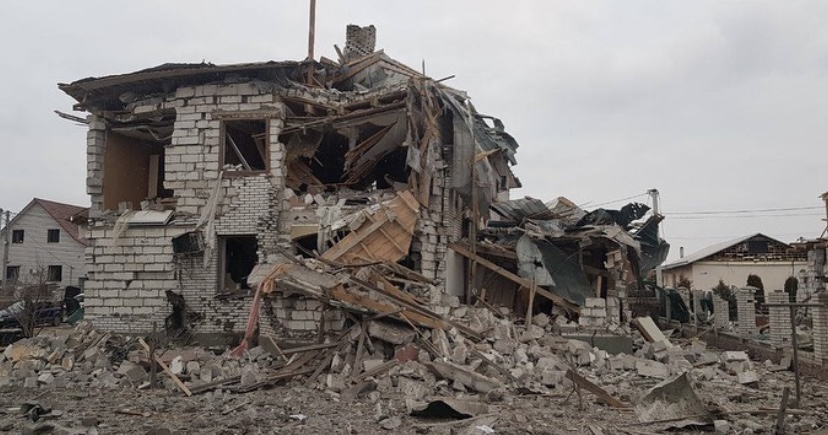Russian invasion of Ukraine hits home for many students
Photo courtesy of Instagram @ukraine.ua
The aftermath of the missile strikes on private houses in the Zhotomyr region.
The longtime conflict between Ukraine and Russia erupted in the early morning of Feb. 24, when several missiles from Russia landed near Kyiv, Ukraine’s capital, and Kharkiv, near the Russian border. These attacks were soon followed by more missile strikes, turning into a full-scale invasion, after Russian President Vladimir Putin officially declared war on Ukraine a few hours later.
Since then, Russia has continued to hit Ukraine with bombs and heavy military presence, under orders from Putin to take over major cities. As of Hi’s Eye print deadline, according to the UN Human Rights body (OHCHR) there have been 1,123 civilian casualties since the start of the Russian invasion.
Despite being 5,000 miles away from the United States, many people in local communities have ties to Ukraine or surrounding countries and are greatly impacted by the invasion. WHS senior Daniela Agne said, “Most of my family is still in Lviv, Ukraine. When I found out on
Thursday morning [about the invasion], it was very hard to control my emotions.”
WHS senior Alice Lisak said, “Seeing my parent’s birthplace bombed and ruthlessly invaded has me shaken and horrified. I think it is a terrifying thing to see families protecting their children, pets and parents, grabbing what they can and from fleeing to distant countries.”
“I have family in Zaporizhzhya, where I was born,” said WHS junior Misha Panayiotou. “[The invasion] impacts me because I see how it’s affecting my grandmother and mom who live with me and they are worried sick for everyone over there. My family in Ukraine is currently using a train station as a bomb shelter.”
Like Panayiotou’s family, many other civilians are taking cover underground to stay protected from the bombings. Others are trying to flee the country, with more than half of the Ukrainian refugees going to Poland. According to theguardian.com, more than 1.3 million Ukrainians have left their home country to seek refuge.
“My family is in Poland which is receiving the largest number of refugees,” said WHS senior Maia Dragowski. “Everyone is either directly or indirectly involved in helping Ukrainians. This, along with fears of Poland being invaded, are the two main topics of conversation.”
The invasion of Ukraine has also caused a lot of fear amongst other countries bordering Russia. WHS junior Krista Rumpeters said, “I have family in Latvia, which is right next to Russia. Many people [there] feel threatened because of how small it is compared to Russia.”
The recent invasion was motivated by Ukraine’s interest in joining NATO, which includes nearby countries such as Latvia, Estonia and Poland. In Putin’s speech, given shortly before he ordered the attacks, he detailed his discontent with the West’s values and with NATO. However, the attack on Feb. 24 was no surprise to Ukraine, as their tensions with Russia go back to 2014, when Ukraine reported the presence of Russian troops in Ukrainian territory, fighting alongside pro-Russian separatists in the Eastern parts of Ukraine. Both countries have had smaller military confrontations throughout the years, before Putin began stationing troops by the Ukrainian-Russian border in November 2021, leading up to his ultimate declaration of violence.
Mount Saint Dominic senior Nina Rakowsky said, “I am heartbroken for my people and devastated about this war, but I cannot say that I am surprised. This war has been set up since 2014. My entire childhood, I have grown up anticipating this war. Ukraine has been calling for help for years.”
President Biden has taken indirect action by condemning Putin’s actions during his State of the Union address, putting sanctions on several Russian financial institutions and limiting trade and transactions with the Russian elite. He has also stationed a total of 6,000 troops in Poland, in the event that Putin continues to invade other nearby countries.
As Russia continues its invasion, Ukraine has stepped up its efforts to defend itself. According to wsws.org, the conscription in Ukraine has expanded to include women between the ages of 18-20, and even pregnant women and mothers of small children will now be conscripted. Ukraine has the most women fighting in the military, at 31,000 women. Civilians are enlisting to fight in the military and many refugees are returning home to defend their country.
Ukrainian President Volodymyr Zelensky has refused to take the U.S.’s offer to help him flee the country, and has chosen to stay and fight for his people, and he was pictured along the front lines of the Ukrainian military.
“The Ukrainians’ bravery throughout all of this and their willingness to give up their lives for their country has been astonishing and inspiring, and I, for one, have never ever been more proud to be Ukrainian,” said Rakowsky.

